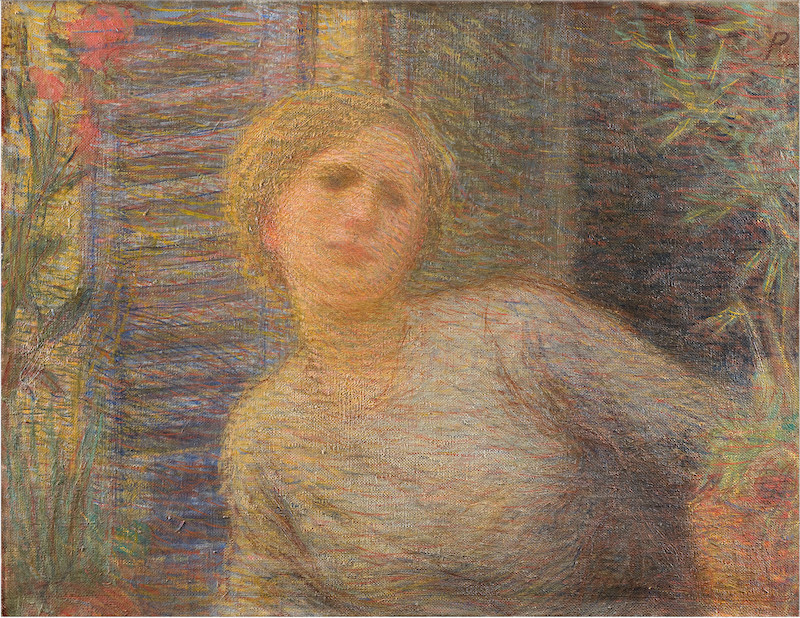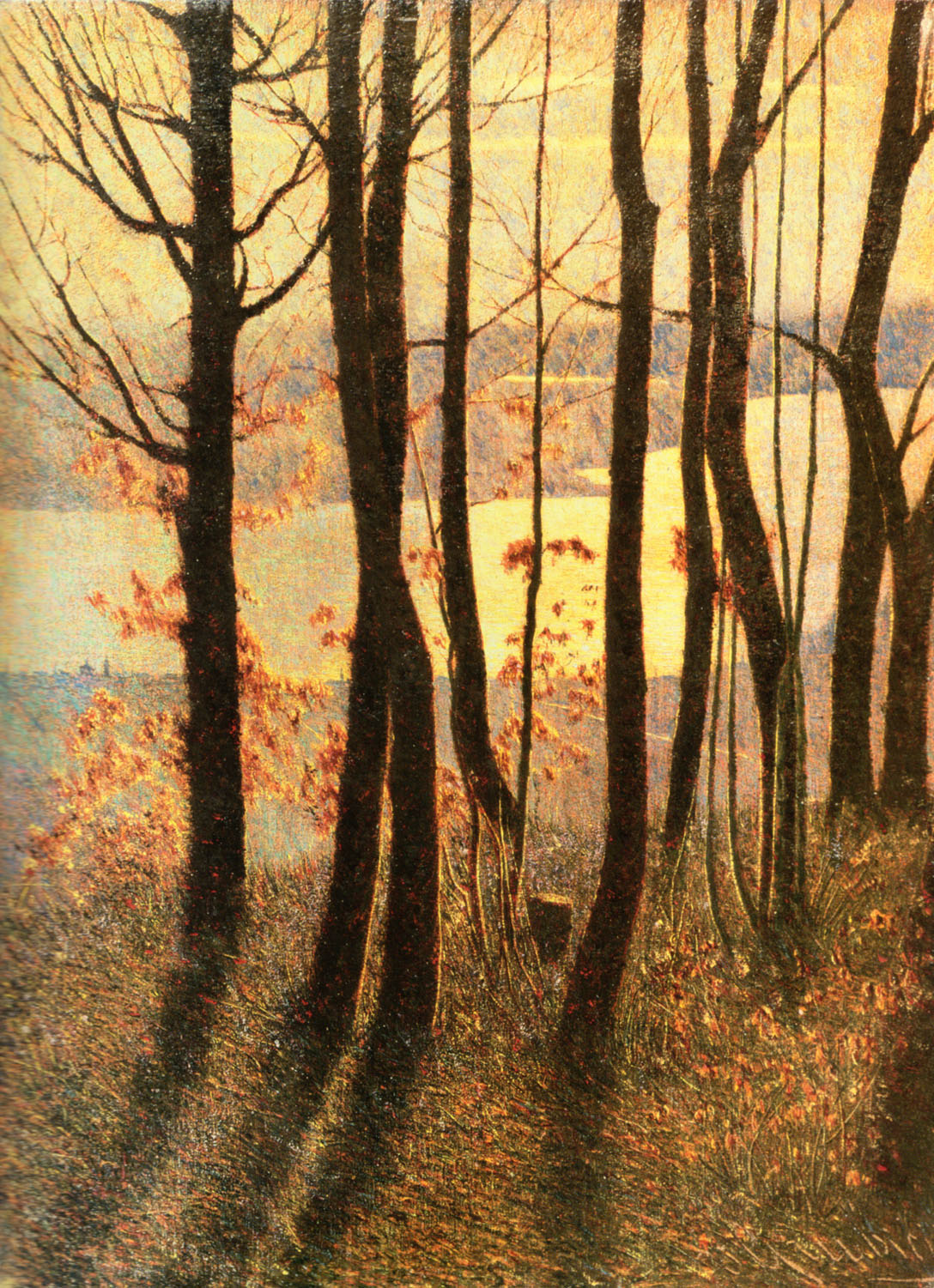|
Pellizza
Giuseppe Pellizza da Volpedo (28 July 1868 – 14 June 1907) was an Italian divisionist painter. He was born and died in Volpedo, in the Piedmont region of northern Italy. Pellizza was a pupil of Pio Sanquirico. He used a divisionist technique in which a painting is created by juxtaposing small dots of paint according to specific color theory. Although he exhibited often, his work achieved popularity in death through their reproduction in socialist magazines and the acclaim they received from 20th century art critics. Biography Giuseppe Pellizza was born in Volpedo, of the Province of Alessandria on July 28, 1868, to Pietro and Maddalena Cantù and into a wealthy peasant family. He attended the technical school of Castelnuovo Scrivia, where he learned the first elements of drawing. Thanks to the knowledge gained with the commercialization of their products, the Pellizzas contacted the brothers Grubicy, who promoted the enrollment of Giuseppe in the Brera Academy. There, Pelliz ... [...More Info...] [...Related Items...] OR: [Wikipedia] [Google] [Baidu] |
Neo-impressionism
Neo-Impressionism is a term coined by French art critic Félix Fénéon in 1886 to describe an art movement founded by Georges Seurat. Seurat's most renowned masterpiece, '' A Sunday Afternoon on the Island of La Grande Jatte'', marked the beginning of this movement when it first made its appearance at an exhibition of the Société des Artistes Indépendants (Salon des Indépendants) in Paris. Around this time, the peak of France's modern era emerged and many painters were in search of new methods. Followers of Neo-Impressionism, in particular, were drawn to modern urban scenes as well as landscapes and seashores. Science-based interpretation of lines and colors influenced Neo-Impressionists' characterization of their own contemporary art. The Pointillist and Divisionist techniques are often mentioned in this context, because they were the dominant techniques in the beginning of the Neo-impressionist movement. Some argue that Neo-Impressionism became the first true avant-gar ... [...More Info...] [...Related Items...] OR: [Wikipedia] [Google] [Baidu] |
Divisionism
Divisionism, also called chromoluminarism, was the characteristic style in Neo-Impressionist painting defined by the separation of colors into individual dots or patches which interacted optically..Homer, William I. ''Seurat and the Science of Painting.'' Cambridge, MA: The MIT Press, 1964. By requiring the viewer to combine the colors optically instead of physically mixing pigments, Divisionists believed they were achieving the maximum luminosity scientifically possible. Georges Seurat founded the style around 1884 as chromoluminarism, drawing from his understanding of the scientific theories of Michel Eugène Chevreul, Ogden Rood and Charles Blanc, among others. Divisionism developed along with another style, Pointillism, which is defined specifically by the use of dots of paint and does not necessarily focus on the separation of colors.Ratliff, Floyd. ''Paul Signac and Color in Neo-Impressionism.'' New York: Rockefeller UP, 1992. . Theoretical foundations and development ... [...More Info...] [...Related Items...] OR: [Wikipedia] [Google] [Baidu] |
Volpedo
Volpedo is a ''comune'' (municipality) in the Province of Alessandria in the Italian region Piedmont, located about east of Turin and about east of Alessandria. Volpedo borders the following municipalities: Casalnoceto, Godiasco, Monleale, Montemarzino, Pozzol Groppo, and Volpeglino. Painter Giuseppe Pellizza da Volpedo was born in this village. History A burial slab, now enclosed in the parish church's walls, shows the Roman presence in the area in the 1st century BC, although the area was perhaps already inhabited by the Ligures. In the 10th century it is documented as ''Vicus Piculus'' (from latin ''vicus'': "Small village") and received a Romanesque pieve and a '' castrum'', a fortified village whose walls, rebuilt in the 16th century, are still visible today. In the 12th century it was known as ''Vicus pecudis'', and was connected to the comune of Tortona, sending relief troops to that city during the siege laid by Frederick Barbarossa in 1155. In 1347 Tortona was ann ... [...More Info...] [...Related Items...] OR: [Wikipedia] [Google] [Baidu] |
Plinio Nomellini
Plinio Nomellini (1866–1943) was an Italian painter. Biography Nomellini was born in Livorno in 1866. In 1885 he enrolled at the Florence Academy of Fine Arts, where he studied under Giovanni Fattori and formed friendships with Telemaco Signorini and Silvestro Lega as well as Giuseppe Pellizza some time later. At the 1886 Promotrice of Florence, he exhibited a portrait and a landscape of ''Un uliveto''; at the 1887 Mostra he exhibited ''L'incontro'' and ''Piano di Tombolo''. In 1888, he exhibited a ''Portrait of Nina Van Zandt'' and ''Il fieno''. At the Mostra held at the Società d'Incoraggiamento of Florence he displayed the following paintings: ''Al sole''; ''Sciopero''; ''La giornata è finita (The Journey is Finished)''; ''Fiore selvaggio''; ''Foce del Calambrone'', and ''The Summer of San Martino''. [...More Info...] [...Related Items...] OR: [Wikipedia] [Google] [Baidu] |
Vittore Grubicy De Dragon
Vittore Grubicy de Dragon (15 October 1851 – 4 August 1920) was an Italian painter, art critic and art gallery owner who was largely responsible for introducing into Italian painting the optical theories of Divisionism. His writings and paintings influenced a generation of late 19th-century Italian painters. In addition, the Grubicy Gallery became one of the first art enterprises to be run on the concept of exhibiting living artists that were represented as clients of the gallery. Biography Grubicy grew up in a well-to-do family in Milan. Both of his parents were great art lovers, and from an early age he was introduced to the art circles in Milan and other European cities. After his father died in 1870, Grubicy became involved with a bohemian group of Milanese artists, poets and writers known as the Scapigliatura, who sought to blur the differences between art and life. He was so taken with this new lifestyle that he convinced his brother Alberto to join him in buying ... [...More Info...] [...Related Items...] OR: [Wikipedia] [Google] [Baidu] |
Giovanni Segantini
Giovanni Segantini (15 January 1858 – 28 September 1899) was an Italian painter known for his large pastoral landscapes of the Alps. He was one of the most famous artists in Europe in the late 19th century, and his paintings were collected by major museums. In later life, he combined a Divisionist painting style with Symbolist images of nature. He was active in Switzerland during the last period of his life. Biography Giovanni Battista Emanuele Maria Segatini 'sic''was born at Arco in Trentino, which was then part of the County of Tyrol in the Austro-Hungarian Empire. He later changed his family name by adding an "n" after the "a". He was the second child of Agostino Segatini (1802–1866) and Margarita De Girardi (1828–1865). His older brother, Lodovico, died in a fire the year Giovanni was born. During the first seven years of his life, his father, who was a tradesman, traveled extensively while looking for work. Except for a six-month period in 1864 when Agostino retur ... [...More Info...] [...Related Items...] OR: [Wikipedia] [Google] [Baidu] |
Pio Sanquirico
Pio Sanquirico (Milan, Austrian Empire 1847–1900) was an Italian painter. Biography Sanquirico mostly exhibited in Italy. In 1880 he was invited to the National Exposition of Fine Arts of Turin, where he exhibited ''In Time of Peace''. In 1881 he exhibited three more paintings, ''Alla frutta'', '' Panfilo Castaldi at the Court of the Sforza'' and ''Discovery and Delusion'' in Turin. The same year he displayed ''Una scoperta''; ''Da Monza a Sesto'', and a series of studies at the Expo of the Society for the Encouragement of the Fine Arts in Florence. In 1883 he painted and exhibited three new canvases: ''Confidenza''; ''Verrà''; and ''Il pulcino nero'' in Milan.The latter was also exhibited in 1883, at the Exhibition in Rome with another painting depicting ''Giordano Bruno Giordano Bruno (; ; la, Iordanus Brunus Nolanus; born Filippo Bruno, January or February 1548 – 17 February 1600) was an Italian philosopher, mathematician, poet, cosmological theorist, and Hermetic ... [...More Info...] [...Related Items...] OR: [Wikipedia] [Google] [Baidu] |
Accademia Carrara
The Accademia Carrara, (), officially Accademia Carrara di Belle Arti di Bergamo, is an art gallery and an academy of fine arts in Bergamo, in Lombardy in northern Italy. The art gallery was established in about 1780 by , a Bergamasco collector or ' of the arts. The academy of fine arts was added to it in 1794. The school was recognised by the Ministero dell'Istruzione, dell'Università e della Ricerca, the Italian ministry of education, in 1988. History The art gallery was established in the early 1780s by , a Bergamasco collector or ' of the arts; by 1785 it was open to some visitors. An academy of fine arts was added to it in 1793 or 1794, initially under the direction of the Milanese painter Carlo Dionigi Sadis. Carrara made his will in 1795, leaving his entire estate to the gallery and art school he had founded; these were to be managed by a five-member commission, of which the first five were chosen by him. He died the next year. In 1810, a new building in ... [...More Info...] [...Related Items...] OR: [Wikipedia] [Google] [Baidu] |
Cesare Tallone
Cesare Tallone (1853–1919) was an Italian painter. Biography Born in Savona and after losing his father at the age of ten, Cesare Tallone moved with his mother and sisters to Alessandria, where he became a pupil of the decorative artist Pietro Sassi. Some members of the local bourgeoisie commissioned the first portraits from him and persuaded the City Council to finance his studies. Thanks to this financial aid, Tallone was able to enrol in the Brera Academy in 1872, studying under Raffaele Casnedi, Luigi Riccardi and Giuseppe Bertini until 1880. His talent was obvious from his very first works and was recognised by Francesco Hayez, who allowed him the use of his own studio near the Academy. An active participant in the lively cultural milieu in Milan and member of the Famiglia Artistica since its foundation in 1873 by Vespasiano Bignami. He won the triennial combined schools of painting competition at the Brera exhibition in 1879, with a historical subject. He reprised t ... [...More Info...] [...Related Items...] OR: [Wikipedia] [Google] [Baidu] |
Accademia Ligustica Di Belle Arti
The Accademia Ligustica di Belle Arti is a tertiary academy of fine arts located in Genoa, Italy. It also houses a museum (Museo dell'Accademia Ligustica di Belle Arti), which includes works of Giovanni Benedetto Castiglione, Giuseppe Abbati, Anton Raphael Mengs, Perin del Vaga, Luca Cambiaso, Bernardo Strozzi, Giovanni Battista Paggi, Sinibaldo Scorza, Domenico Fiasella, Luciano Borzone Luciano Borzone (1590 – 12 July 1645) was an Italian painter of a late- Mannerist and early-Baroque styles active mainly in his natal city of Genoa. Biography After an apprenticeship with Filippo Bertolotto, his uncle, the Duke Alberigo ..., Serafino De Tivoli, Plinio Nomellini. The academy was founded in 1751. References External links * Art schools in Italy Education in Genoa Educational institutions established in 1751 1751 establishments in Italy Art museums and galleries in Genoa {{Italy-art-stub ... [...More Info...] [...Related Items...] OR: [Wikipedia] [Google] [Baidu] |
Angelo Morbelli
Angelo Morbelli ( Alessandria, 1853 – Milan, 1919) was an Italian painter of the Divisionist style. Biography A grant from the City Council of Alessandria enabled Morbelli to enrol at the Brera Academy of Fine Arts, Milan, in 1867. He was awarded the Fumagalli Prize at the Brera exhibition of 1883 for Last Days (Milan, Galleria d’Arte Moderna) as well as a gold medal at the Paris Universal Exhibition of 1889. The work inaugurated a series of paintings on the Pio Albergo Trivulzio home for the aged, which was accompanied by others addressing social themes. He took part in the 1st Brera Triennale in 1891 with work of a Divisionist character. The Divisionist technique of separate colours was also employed in socially committed works subsequently shown at the exhibitions in Milan, Venice and Rome and the intense landscapes that followed them towards the second decade of the new century. One of his pupils was Pietro Morando. [...More Info...] [...Related Items...] OR: [Wikipedia] [Google] [Baidu] |







